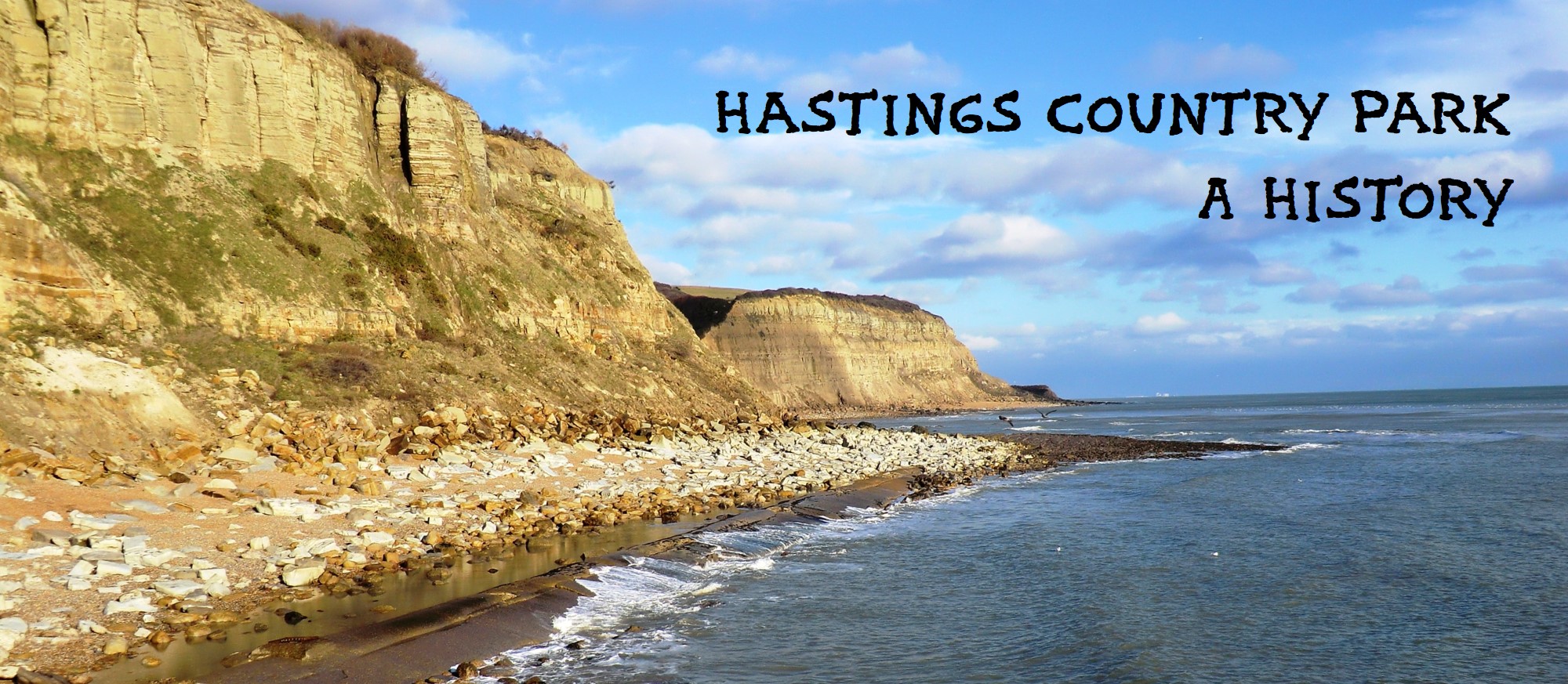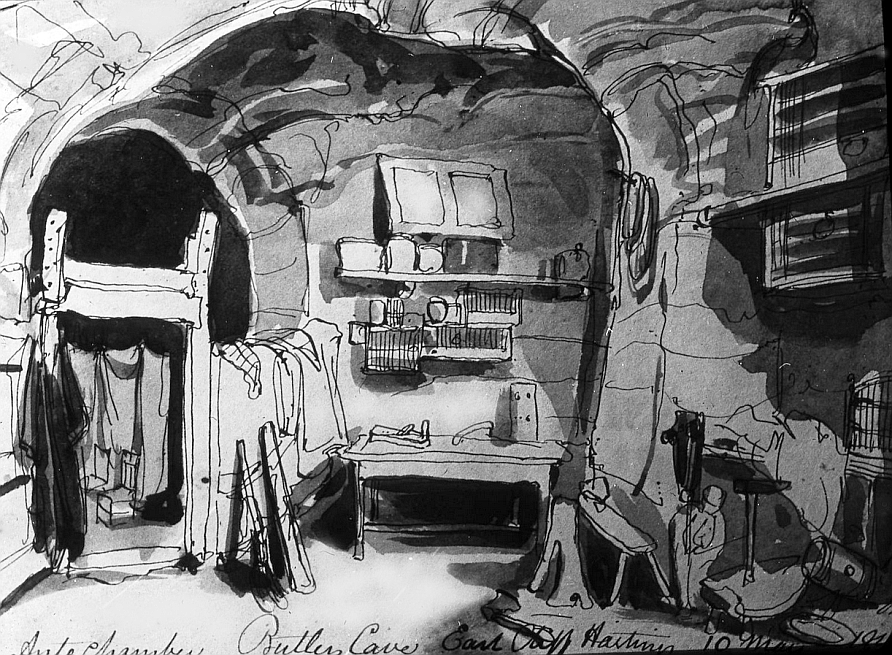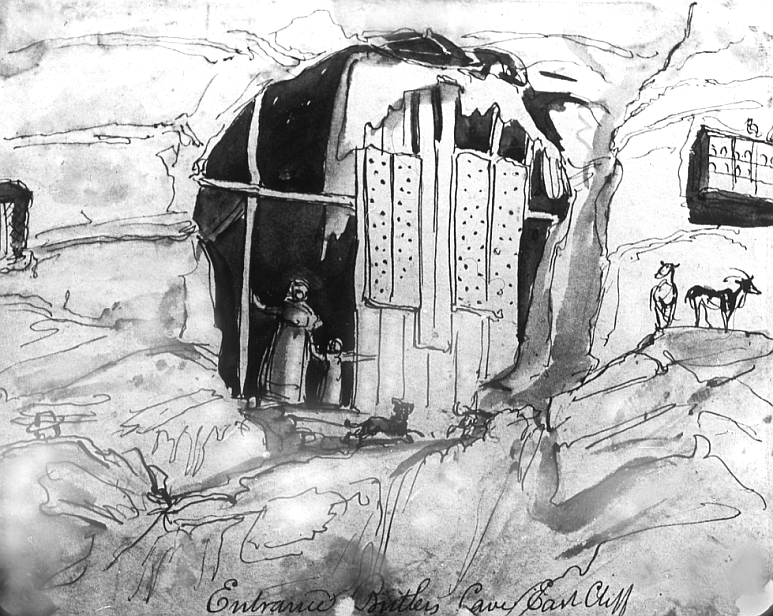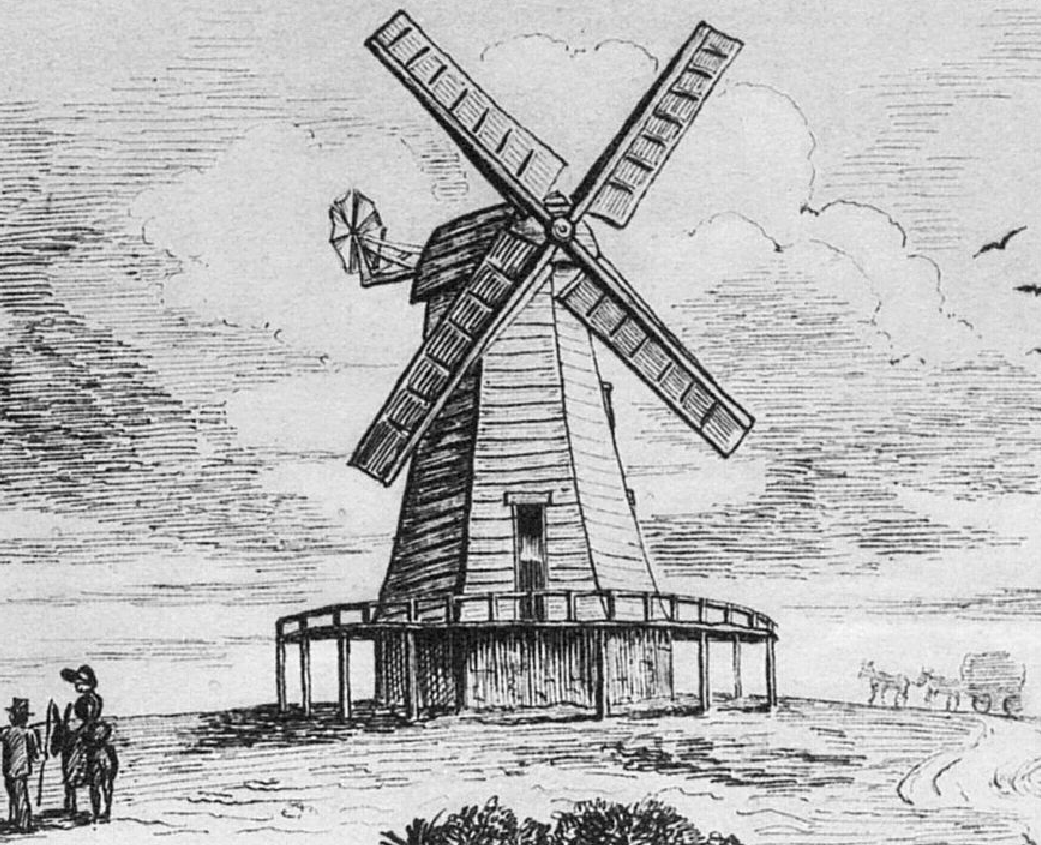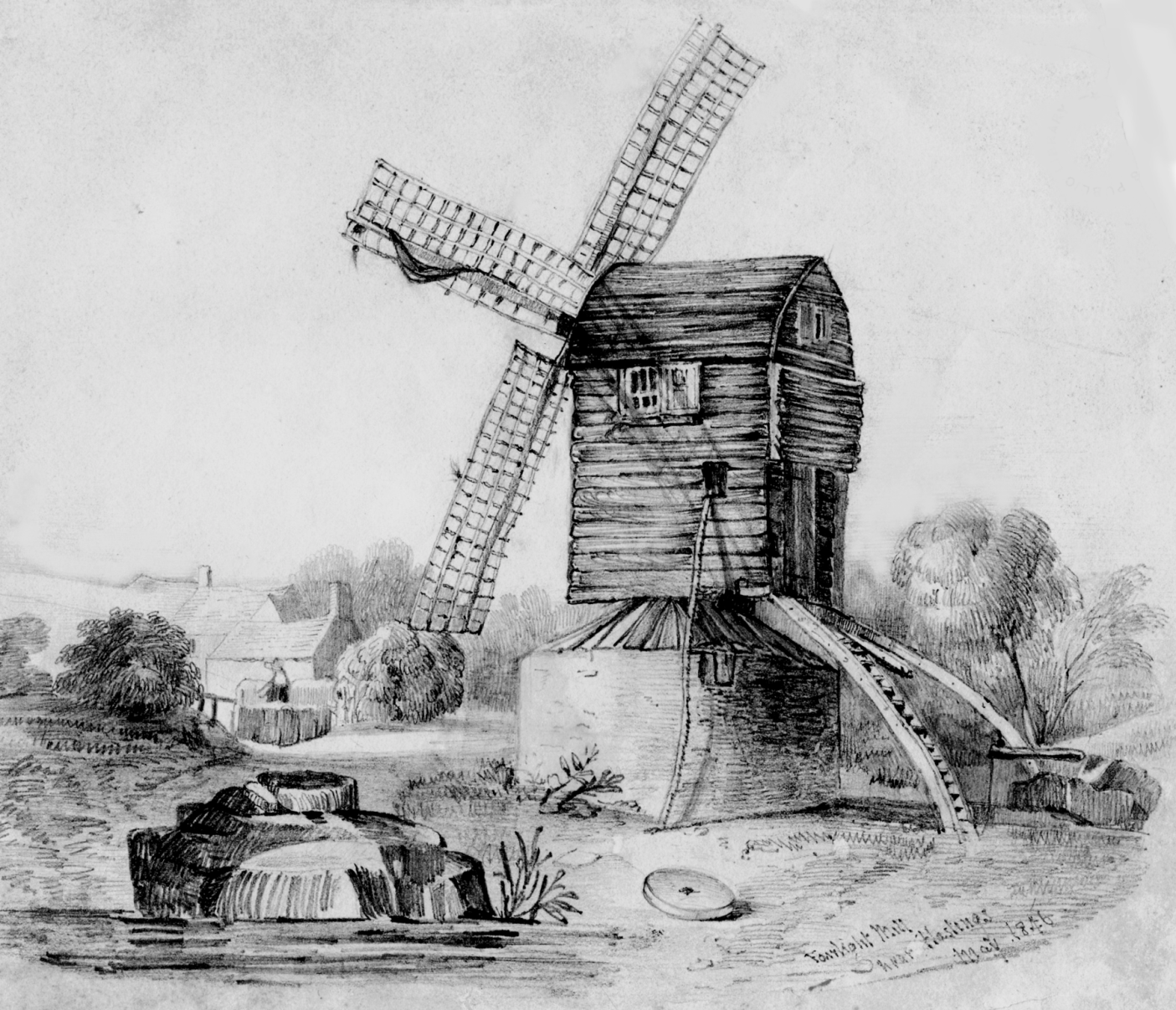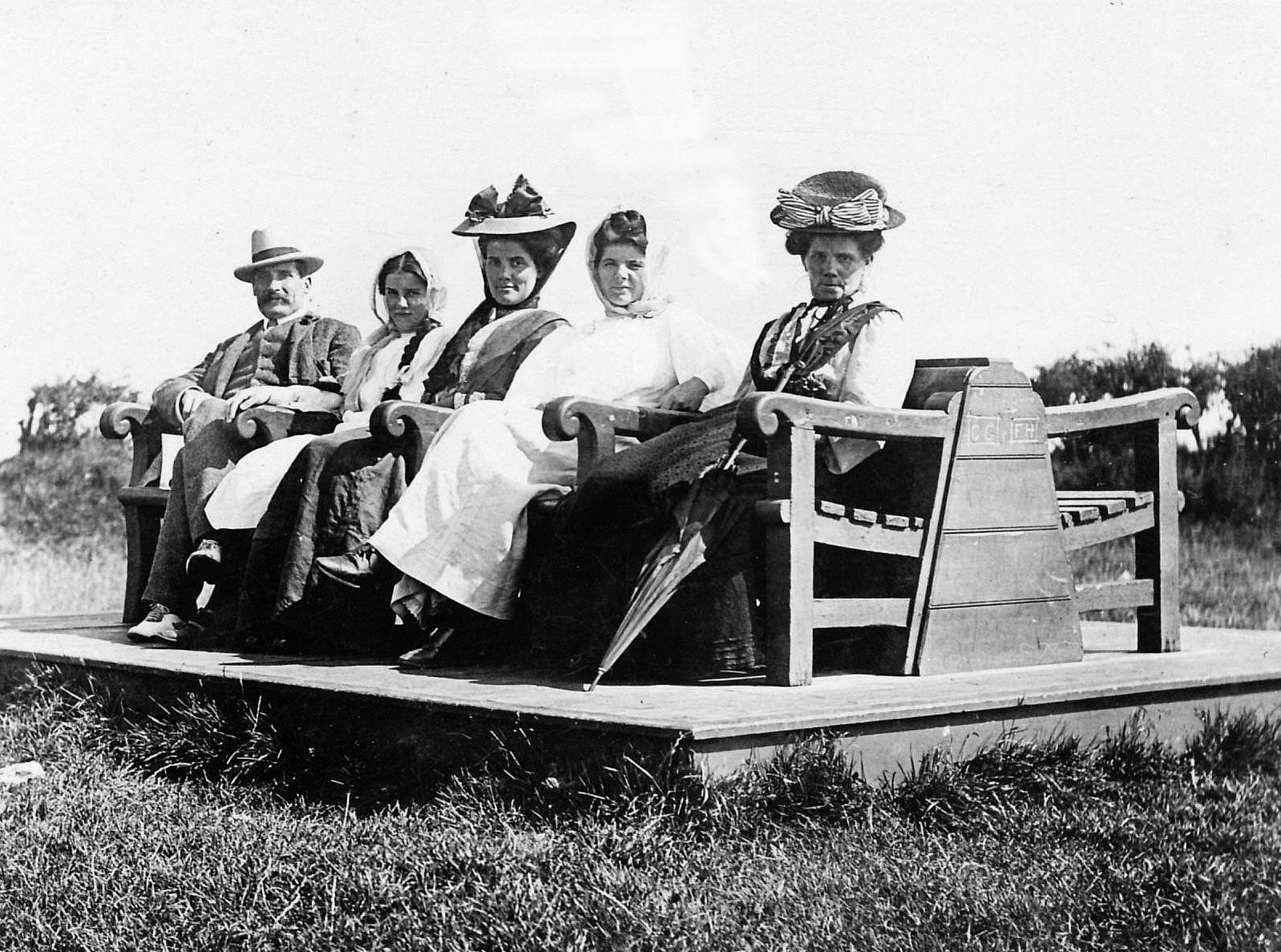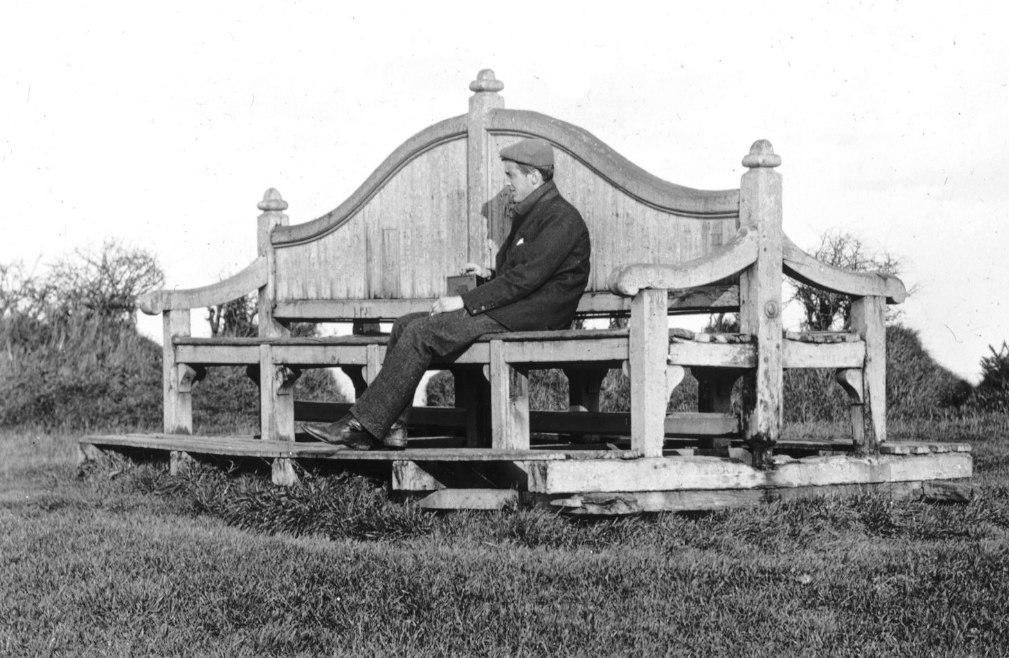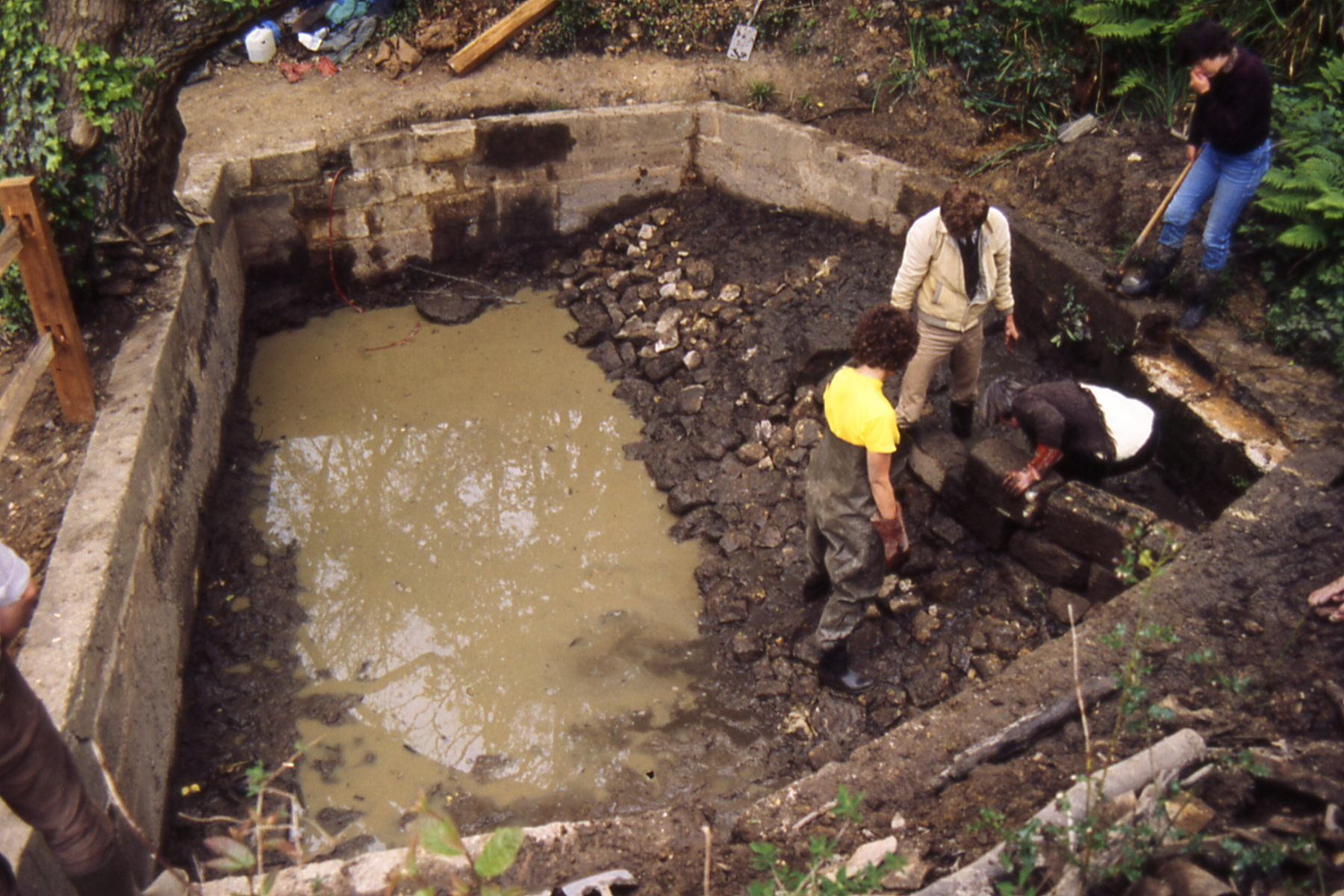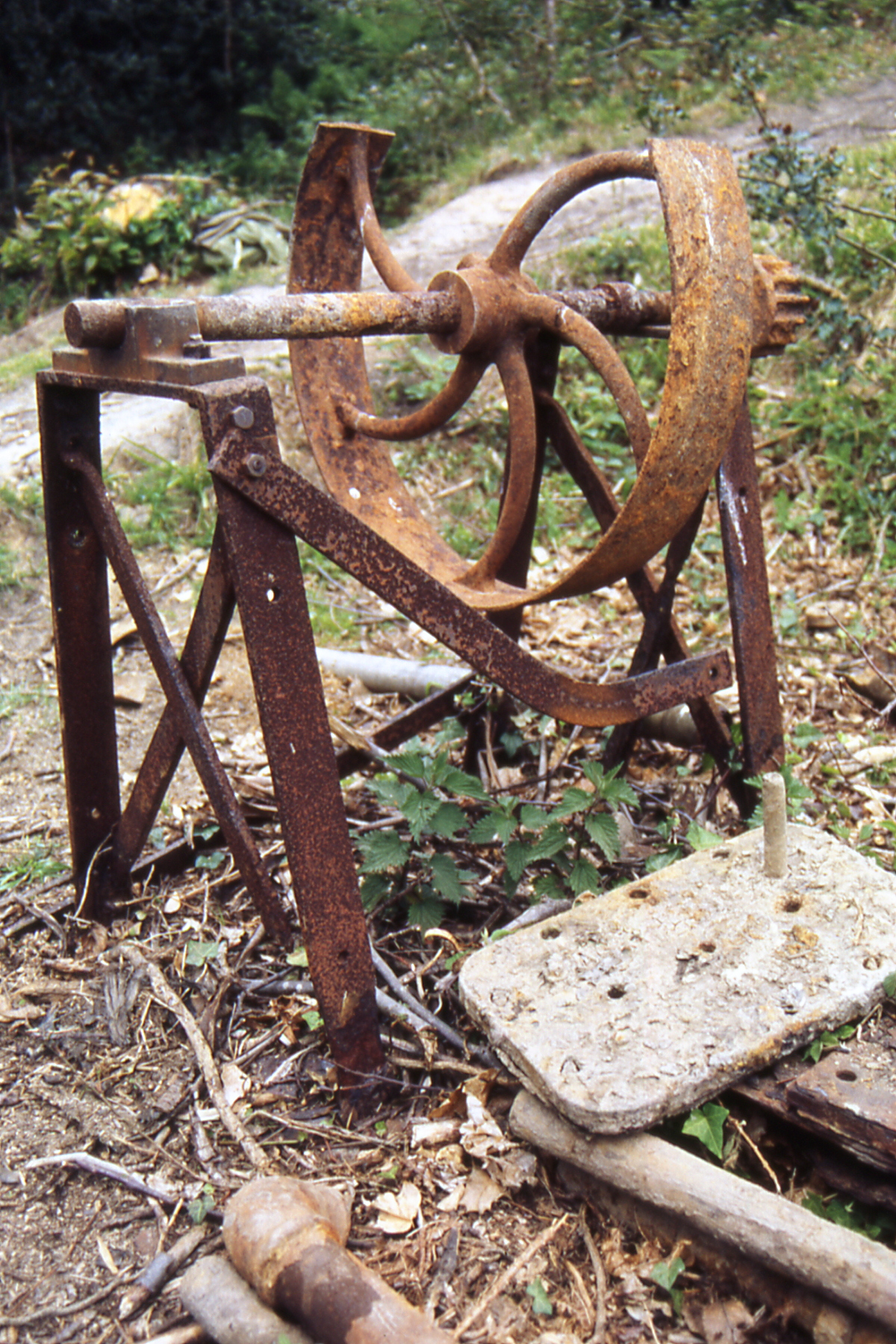1850-1899
1850 Jan 10 - An eagle was shot under the ‘East Cliff’ near Pett. It weighed 8½ pounds, was three feet long and had a wingspan of 6½ feet. Victorian historian Thomas B Brett reported seeing an eagle in the Hastings area in 1844.
1850-55 - Fairlight Hall was built, off Martineau Lane, by William Drew Lucas-Shadwell (1817-75). He was the nephew of William Lucas-Shadwell (1765-1844), the Hastings solicitor and property conveyancer, who had made a fortune supplying stone for the building of the Martello Towers early in the 19th century. He left Drew his huge estate to the east of Hastings. The Hall is built of local sandstone in Gothic Revival style, with battlements. The Hall was designed by the architect of Hyde Park Gardens, John Crake, who was a pupil of St Leonards architect Decimus Burton. William Snr lived for some of his time in the house at the top of All Saints Street that was to become All Saints Rectory, directly opposite the Milward residence at Old Hastings House. The Milwards and Lucas-Shadwells jointly through much of the 19th century gave much help to local charities and carried out local improvements, including the upgrading of Old London Road from the High Street to Mount Road in 1815.
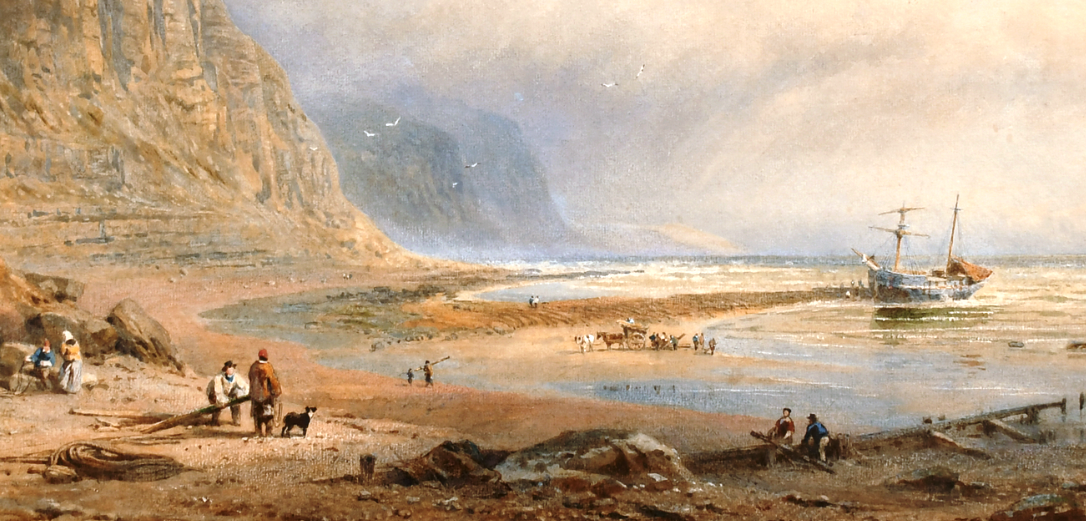 There were many shipwrecks along the Sussex coast in the 19th century. This is one just east of Rock-a-Nore recorded by artist Henry G Hine, showing a topsail schooner on the rocks. The date is unknown, but is probably early Victorian.1851 - Hastings was running short of water, so the council persuaded Countess Waldegrave to lease them three acres at the top of Ecclesbourne Glen to build a six million gallon reservoir, plus a tunnel, 470 yards long, feeding the water into the two Clive Vale reservoirs. Work started that May, and was completed in March 1853, at a cost of £2,500. In 1921-4 the council raised the height of the reservoir’s dam, doubling its capacity. The council required another two acres of land for this, and in 1924 it purchased all five acres from Edith Sayer-Milward. Officials liked to call it the Ecclesbourne Reservoir, but its local name was the Spoon.
There were many shipwrecks along the Sussex coast in the 19th century. This is one just east of Rock-a-Nore recorded by artist Henry G Hine, showing a topsail schooner on the rocks. The date is unknown, but is probably early Victorian.1851 - Hastings was running short of water, so the council persuaded Countess Waldegrave to lease them three acres at the top of Ecclesbourne Glen to build a six million gallon reservoir, plus a tunnel, 470 yards long, feeding the water into the two Clive Vale reservoirs. Work started that May, and was completed in March 1853, at a cost of £2,500. In 1921-4 the council raised the height of the reservoir’s dam, doubling its capacity. The council required another two acres of land for this, and in 1924 it purchased all five acres from Edith Sayer-Milward. Officials liked to call it the Ecclesbourne Reservoir, but its local name was the Spoon.
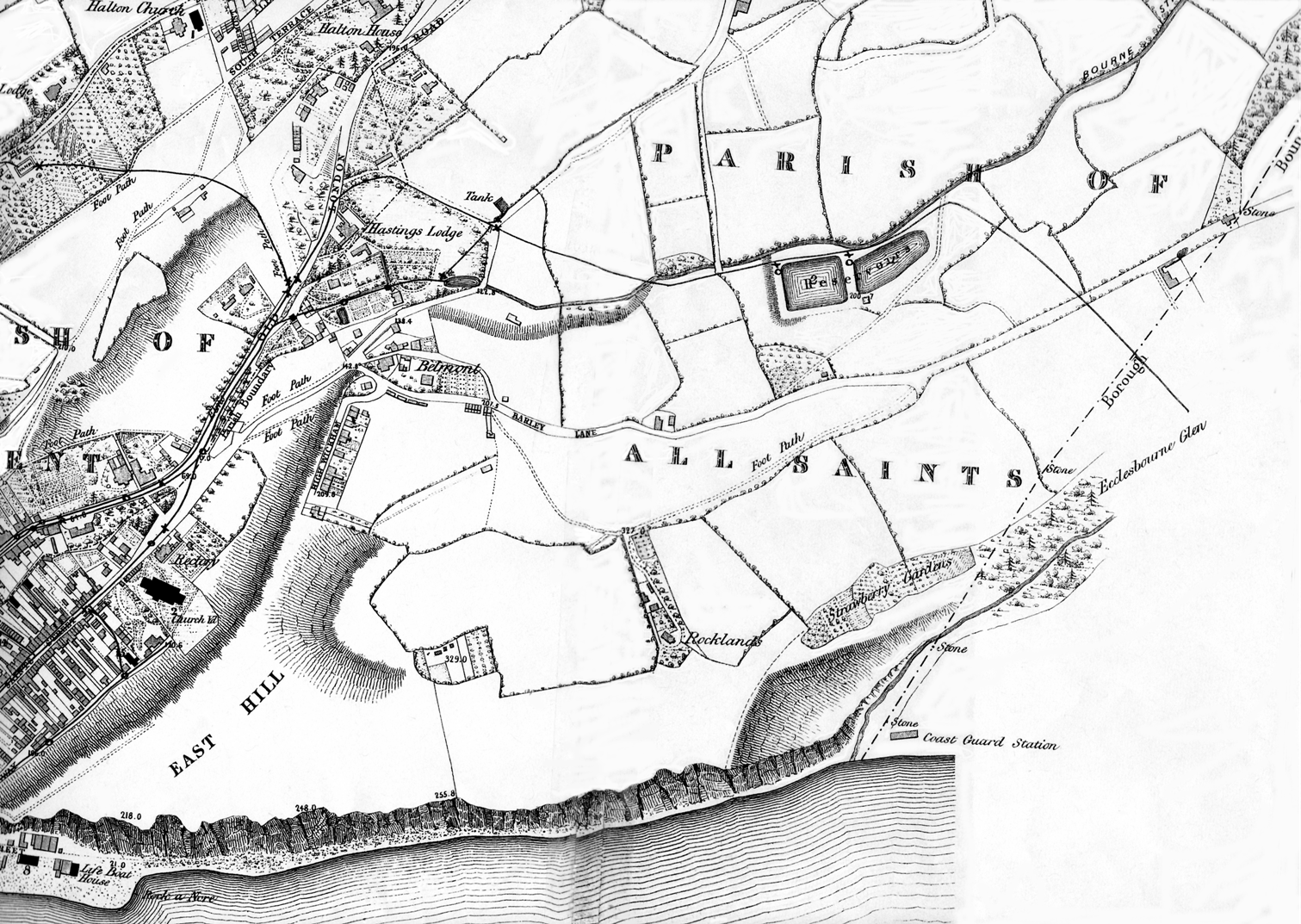 This 1859 map by the borough surveyor John Laing shows the pipeline running from the Spoon (which was outside the borough, so not on the map) under Barley Lane to the Clive Vale reservoirs. From there, pipelines are marked going to parts of the Old Town. Construction of Clive Vale had not begun.
This 1859 map by the borough surveyor John Laing shows the pipeline running from the Spoon (which was outside the borough, so not on the map) under Barley Lane to the Clive Vale reservoirs. From there, pipelines are marked going to parts of the Old Town. Construction of Clive Vale had not begun.
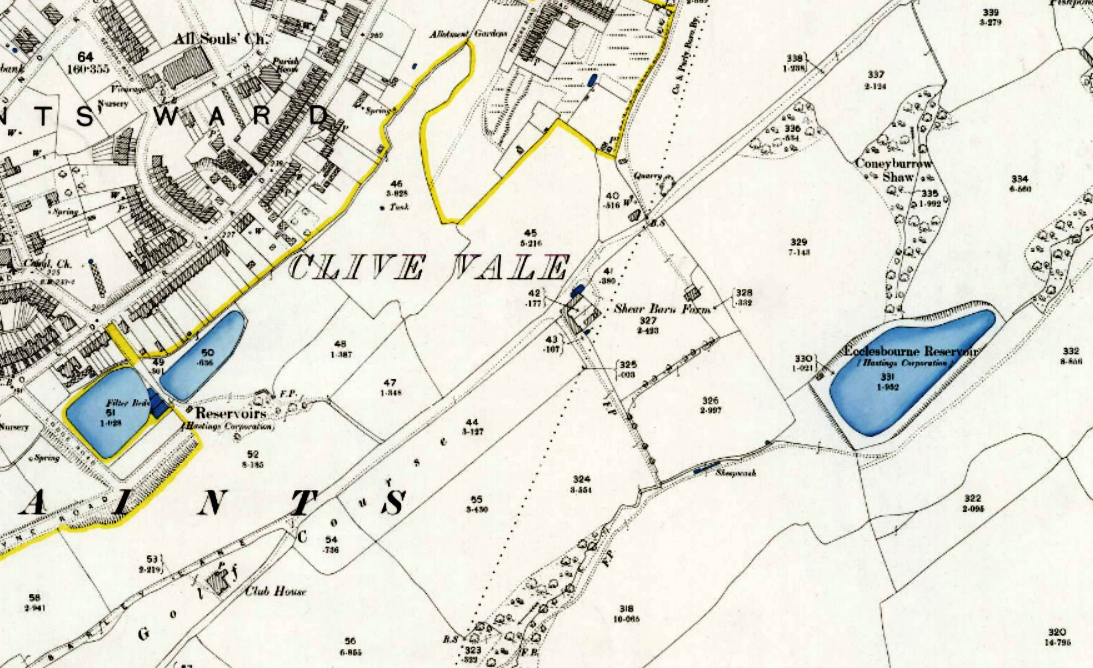 The Spoon, on the right, and the two Clive Vale reservoirs (known as the 'rezzies') in 1897.
The Spoon, on the right, and the two Clive Vale reservoirs (known as the 'rezzies') in 1897.
1852 Summer - Pre-Raphaelite artist William Holman Hunt painted his greatest landscape, Our English Coasts, later known as Strayed Sheep, portraying the view looking west across Fairlight Glen from above Lovers' Seat. Then aged 25, Hunt had heard of Hastings through one of his pupils, Robert Martineau, whose parents were living at Fairlight Lodge (on the corner of Martineau Lane). Early in 1852 Martineau introduced Hunt to the ‘nonsense’ writer and artist Edward Lear. As Hunt had a commission to paint a picture with sheep in it, he decided to do it near Fairlight, and Lear found him an ideal place to stay: Clive Vale Farm. This was sited in Clive Vale, where there are houses south-east of the junction of Saxon Road and Alfred Road today. Hunt and Lear stayed at the farm for several weeks, and were contacted there by John Millais, William Rossetti, Coventry Patmore, Arthur Hughes and William Thackeray. Hunt and Millais also stayed and painted at Fairlight Lodge.
 Our English Coasts, by William Holman Hunt in 1852.
Our English Coasts, by William Holman Hunt in 1852.
1853 - Knight's Excursion Companion published a profile of a family living in an excavated 'cavern' (cave) a 'good height up the cliff' at Rock-a-Nore. Mr Knight said 'The head of the family is an Irishman named Butler, who, about a dozen years ago, chose to fix on this windy elevation for his cabin, and enlarged the existing excavations so as to form a good-sized sitting room with a sleeping room beyond. He has a wife, children and grandchildren, who live here with him; and the family is further increased by miscellaneous assemblage of pigs,dogs, rabbits, goats and squirrels; geese, ducks, turkeys, fowls, Guinea-fowls, pigeons and a variety of other bipeds and quadrupeds - all dwelling socially and pleasantly together. On our last visit, the old man sat dozing on one side of the fire; a matronly-looking hen with a brood of chickens about her was on the other. The wife was earnestly engaged in appeasing the clamours of a hungry pig, and arbitrating between two noisy brats. The daughter was preparing dinner, and holding a friendly conversation with the ducks. Around the room were birds in cages,while others were flying or hopping about at large; and all appeared very well contented with their situation and occupation.' Mr Butler paid 'a nominal rent for his cavern', presumably to the Countess Waldegrave, who owned the cliffs.
1855 June - A song about Fairlight Glen, Music of the Stream, was published, with words by Arthur Ransom and music by George Lindridge.
1856 Aug - Hastings mayor Thomas Ross carried out the earliest recorded archaeological excavation on the East Hill, at the south-west end, close to where the lift is today. His interest in the hill was sparked by a feature resembling a tower on an ancient map, which he assumed to be the base of a Roman lighthouse (pharos). He found an east-west aligned wall footing, approximately 100 feet long, with a second wall joining it at right angles at the western end and extending to the cliff edge. Within the walls he excavated a Caen stone cist or coffin, and at least 40 inhumation burials, some lying on beds of charcoal and one including a skull of ‘extraordinary thickness’. He also located a flint arrowhead and a portion of window splay. It is possible that this was a Saxon site.
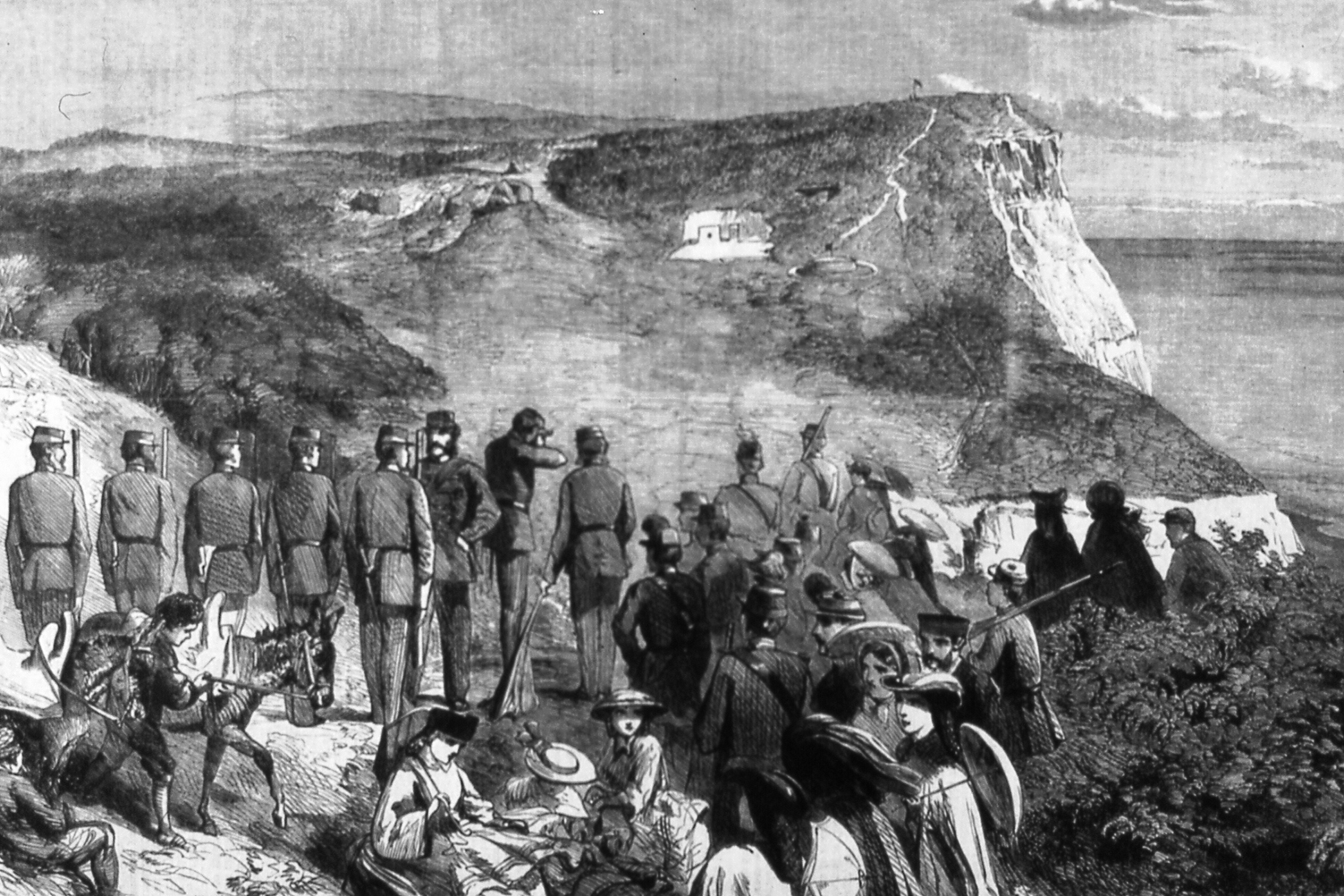 A display of rifle firing and fashion at the Ecclesbourne Glen range in the 1860s. From the Illustrated London News.
A display of rifle firing and fashion at the Ecclesbourne Glen range in the 1860s. From the Illustrated London News.
1859 May - A Hastings rifle company was formed, which in November 1859 officially became the First Company of the Cinque Ports Rifles Volunteers. It was set up because of fears of imminent hostility with France. In the summer of 1859 Countess Waldegrave let them set up a rifle range across Ecclesbourne Glen, firing from the East Hill to butts just below the top of the eastern side of the glen. The remains of it can still be seen in much later photographs. Drilling took place in the Market Hall in George Street, next to the Anchor pub. In the spring of 1862, as there were still fears of hostility with France, a volunteer artillery company was set up, which constructed a small artillery battery at the bottom of Warren Glen. It was on the east side of the stream, close to the edge of the cliff, firing out to sea. It was a quadrangle of earthen walls, with a gun shed and store house. In May 1862 two 18-pounder cannon were installed. The site for a rifle range in Warren Glen was identified at the same time, and this was set up. It was located about halfway up the glen, firing north-east from the west side, almost on the site of the one to be created in 1901. Its target is shown on the 1873 Ordnance Survey map, as is the artillery battery, but neither are on the next edition, of 1897. The battery had probably slipped over the cliff, while the rifle range had probably fallen out of use.
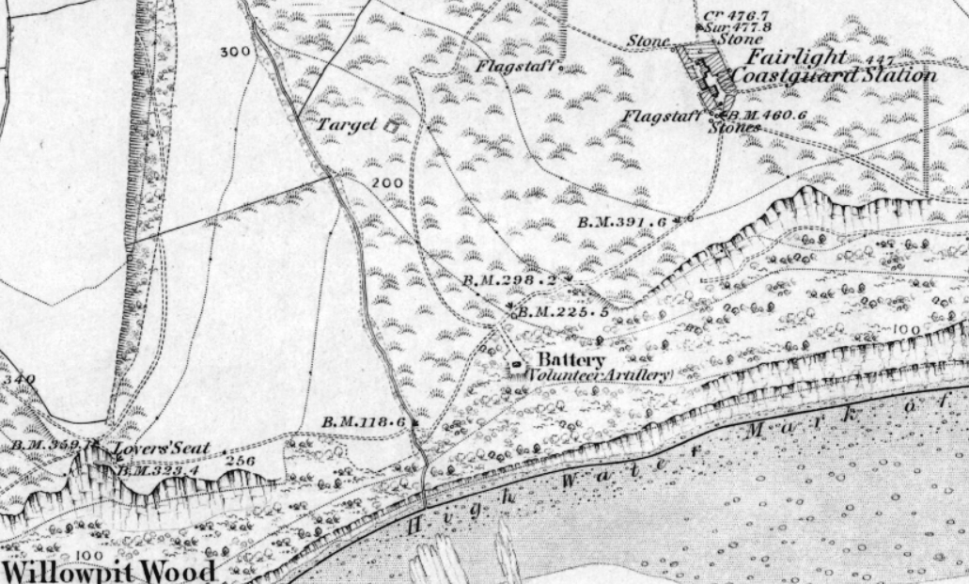 The 1873 OS map. showing the rifle target and the artillery battery in Warren Glen.1859 Oct 25 - A storm made the wooden Ecclesbourne Coastguard Station standing almost on the beach uninhabitable; it had been insecure for a long time. In 1861 a replacement station was built on the west side of the glen, set back from the cliff edge. It was brick built, with rendering, in two blocks, with a yard in front collecting rainwater into an underground brick tank. This was the Coastguard Station that appeared in many photos, and which survived until 1963. The Coastguard occupied land uphill to the rock-face marking the west edge of the glen.
The 1873 OS map. showing the rifle target and the artillery battery in Warren Glen.1859 Oct 25 - A storm made the wooden Ecclesbourne Coastguard Station standing almost on the beach uninhabitable; it had been insecure for a long time. In 1861 a replacement station was built on the west side of the glen, set back from the cliff edge. It was brick built, with rendering, in two blocks, with a yard in front collecting rainwater into an underground brick tank. This was the Coastguard Station that appeared in many photos, and which survived until 1963. The Coastguard occupied land uphill to the rock-face marking the west edge of the glen.
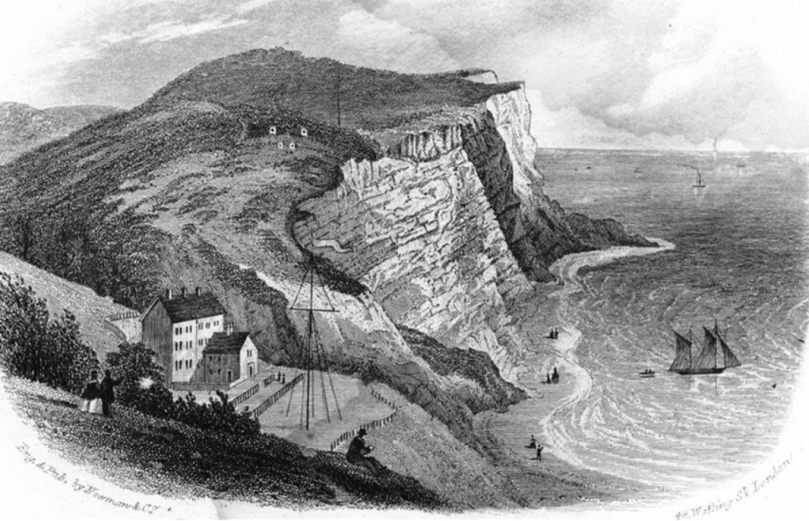 The new Coastguard Station, in the late 1860s.
The new Coastguard Station, in the late 1860s.
1862 May 31 - Clive Vale Farm was sold for £7,900 to the Freehold Land Society. The farm consisted of 60 acres of land between Old London Road and the western boundary of Fishponds Farm (within the parish of All Saints). It had been the property of the late John Mercer Durrant Esq and his ancestors for a century and a half, up to 1832, when it had been sold to the late John Samworth Esq for £3,500. The 60 acres of farmland were to be the site of the new suburb of Clive Vale, with the road layout and housing plots being laid out in the following years.
1864 Summer - The Central Cricket Ground came into being on the site of today’s Priory Meadow shopping centre, having just been leased following public meetings. It replaced the cricket ground on top of the East Hill as the town’s main cricket pitch, although cricket was played on the East Hill until recently.
1868 Summer - The town’s new drainage system was completed, with a 1½ million gallon sewage and rainfall tank at Rock-a-Nore, and its outfall pipe running out to low-water, off Ecclesbourne Glen. Sections of the pipe are still in place, and visible at low water.
1869 April 21 - The landmark windmill on top of Fairlight Down burnt down. Built in 1819, it was well-known both locally and to seafarers. Three granaries surrounding the mill were also destroyed. Fairlight Mill had been owned by the Countess Waldegrave, but occupied by William Crisford, who owned the nearby Guestling wind and steam mill. The mill, made of overlapping boarding coated in tar, was not replaced, and on its site in April 1870 a large seat for 12 people, made by GE Jones of York Gardens, was erected by the famous artist Miss Marianne North in memory of her father Frederick North MP, who had died 29 October 1869. It was named North’s Seat, with a sign saying 'Frederick North, his seat'. The Hastings News suggested removing the scrub hedge which was blocking the extensive views. In the years following it suffered much vandalism. In July 1938 North's seat and its surroundings was sold by the Milward Estate to Hastings Council for £100.
1872 Oct - Hastings Council agreed to spend £5,500 on the ‘East End Springs’ scheme: extracting water from streams in Fairlight Glen and Warren Glen. Over the following months, both glens had a 700,000 gallon reservoir built near where their main stream went down onto the beach, plus a 50,000 gallon on a side stream, totalling 1.5 million gallons. This water was pumped to Rock-a-Nore water pumping station via a cast iron main laid along the bottom of the cliff. By 1875 the scheme was supplying 78,000 gallons a day, and other springs in the two glens were added to the system soon after. The system closed in 1892 when other water supplies had been set up from Crowhurst Marshes, and the iron pipes under the cliff were taken up and used to connect the Marshes with Filsham pumping station. A small reservoir still survives, on a small stream on the east side of Warren Glen, plus an hydraulic ram near the cliff that helped push the water along the beach.
1873 - In the book Smugglers and Smuggling by well-known local personality John Banks, he wrote: 'The smugglers had a curious way of naming different parts of the coast, thus - "Jinns’s Stool" was a large rock near Galley Hill [Bexhill]; "The Slide", a place near Rock-a-Nore; "The Whippings", the high cliff near Ecclesbourne; "Robin Whiting’s Hole", just beyond Ecclesbourne; "Broken Shins" and the "Gringer", further east; and the "Marrow-bone Gap" near Fairlight Signal Station.'
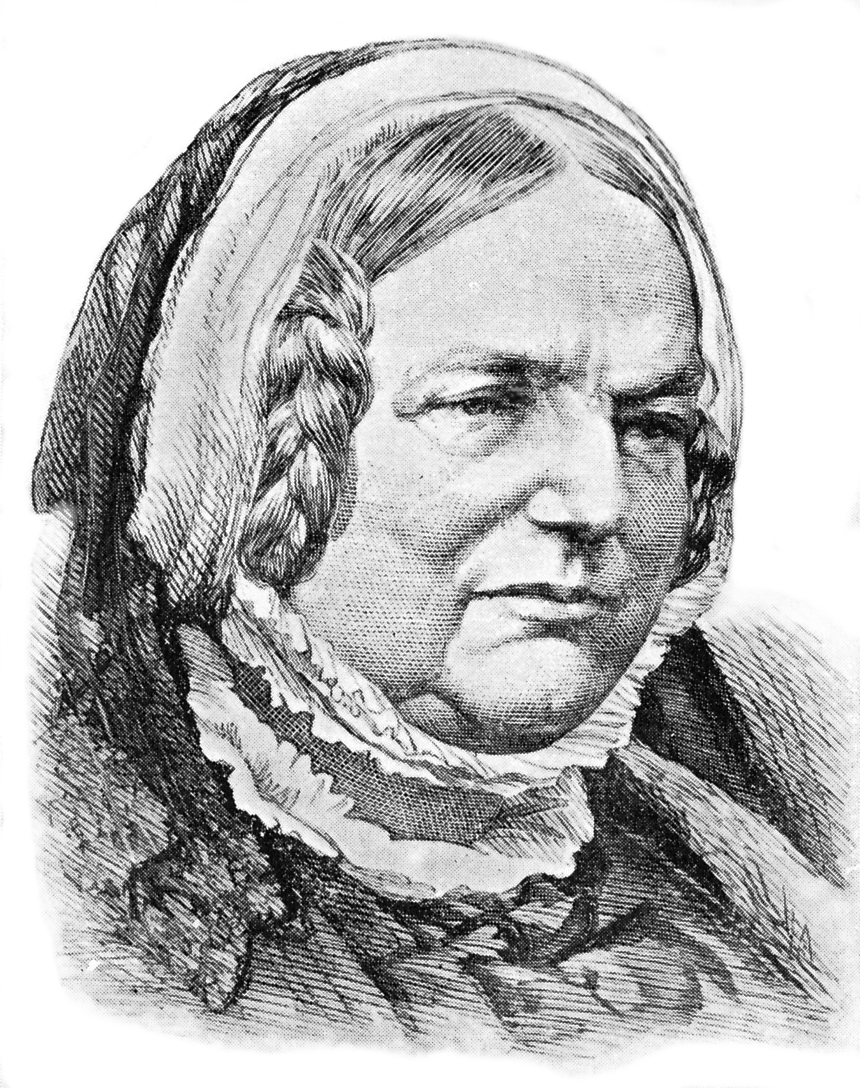
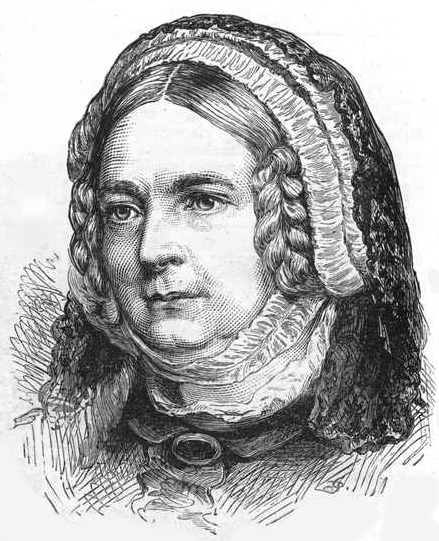
The Countess Waldegrave, old and young.
1873 April 18 - Sarah, Countess Waldegrave, manager of the Milward Estate, died, in her 87th year. She was then said by the rates valuers to be responsible for 2,357 acres of land. (The other owners of big estates in the Hastings area were Humphrey Burton with 540 acres in St Leonards, Wastel Brisco 4,390 acres, George Clement 502 acres, the Duchess of Leeds 638 acres, Mr Montefiore 1,422 acres, the North family 820 acres and William Lucas-Shadwell of Fairlight 3,689.) The Hastings News of 2 May reported her burial at Fairlight; and on 20 June said that in her will was an estate of nearly £60,000. As she had no children, the estate passed to Edward Henry Sayer-Milward (1835-90), a grandson of Sarah Collier, who was a sister of the wife of Edward Milward Snr. But Mr Sayer-Milward was recorded as being ‘of unsound mind’ in 1883 (and probably so before then) and it was actually his brother, London solicitor Charles Sayer, who ran the estate. Charles was less public-spirited than the Countess, selling parts of the estate at high prices for housing development (such as Milward Road) following the death of his charity-oriented aunt Miss Mary Sayer in 1880. On Edward Sayer-Milward’s death in 1890 the estate passed from Charles into the hands of a more public-spirited third brother, the Rev William Carlisle Sayer-Milward (born 1837), who moved into Fairlight Place in 1898, and died in 1913.
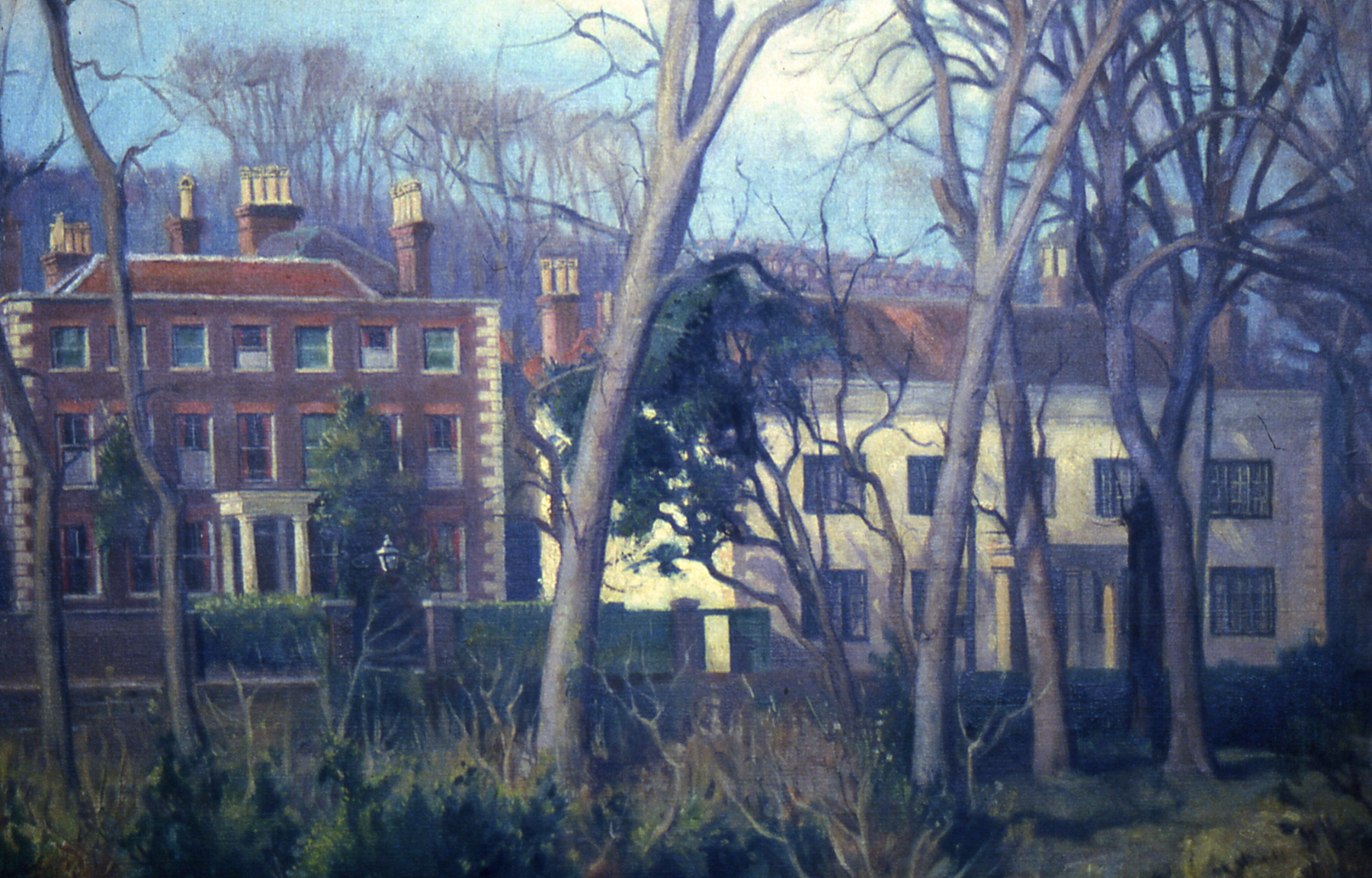 Old Hastings House (on the left), the Milwards family home at the top of the High Street, seen here before the trees were cleared and The Bourne main road was built c1960.
Old Hastings House (on the left), the Milwards family home at the top of the High Street, seen here before the trees were cleared and The Bourne main road was built c1960.
1878 Feb 28 - The death occurred at Fairlight Place of the Reverend Francis William Rhodes, father of the British imperialist and diamond magnate Cecil Rhodes. The Reverend, from Bishops Stortford, had rented Fairlight Place because of an illness, and was living there with two of his four daughters. He also had eight sons, with Cecil Rhodes (1853-1902) then working in southern African in the colonised territory that in 1894 was named Rhodesia (now Zimbabwe). After the Reverend’s death, the daughters remained at Fairlight Place until the late 1890s, with one of them, Edith, being well-known for the help she gave to Hastings charities, especially in the Old Town. Brother Cecil may have visited the sisters. They left Fairlight Place in 1898, and the Hastings Observer of 9 June 1900 later recalled that 'The Misses Rhodes, besides possessing very charming personalities, are thorough sportswomen, and extremely fond of horse-riding.' Edith in 1904 moved into North Lodge in Upper Maze Hill, St Leonards, where she died in January 1905, aged 56. She was buried in Fairlight Churchyard, with her grave being next to that of her father Francis and his wife Louisa.
1880 May - The new Harold Tea and Pleasure Gardens opened. They were at Pinders Shaw, on the east side of the upper Clive Vale valley. They were built by Mr W Rogers, who had a large temperance hotel. There was a big dancing area at the west end of the gardens, capable of holding several hundred people. The nearest pub was a mile away.
1880 Oct 21 - The respected Miss Mary Sayer died, aged 79, at her residence, Parade House (where Marine Parade runs into the west end of George Street). She had been in a feeble state for some time, and had just returned from her country residence at Chailey. She was the daughter of the late Henry Jenkinson Sayer, and the aunt of Edward Sayer-Milward, the nominal owner of the Milward Estate. Miss Sayer’s death prompted the gradual break-up and sale of this important estate by her nephew Charles. She and her sister Miss Maria Jane Sayer (1808-1887) donated to many local causes, charities and churches. The Hastings News said: 'In her private life the poor and needy have invariably found in her a sympathising friend.' The sisters had played key roles in founding the St Andrews Church in Queens Road and St Andrews School in Stonefield Road.
1881 Dec 18 - Hurricane-force winds drove a sailing vessel onto the rocks near the Haddocks Coastguard Station, Fairlight Cove, at 5.30 on the morning of Sunday 18 December. The German barque Sacitta was outward bound from Hamburg to Mexico with a general cargo, including pianos, utensils, rifles, toys, twine and a large amount of alcohol in the form of casks and bottles of spirits and bottles of beer. The vessel struck a reef near the Haddocks and immediately broke in two. One crewman survived the wrecking, being washed ashore, but the other five drowned. By Monday the whole coast from Fairlight nearly to Rye was thickly strewn with an enormous quantity of cargo and wreckage, viewed by many people. The Hastings News said: 'The intermixture was scanned over very eagerly by parties whose conduct obtained for them the name of "Wreckers", but after they had collected a load of booty a Coastguardman would in most instances succeed in getting the goods "handed over".' Some were very saucy and were arrested. The local receiver of wrecks, Mr JC Vidler, had the most valuable goods taken to the Custom House in Rye, with other items stored in the local Coastguard stations, which were soon overflowing. 'Large numbers of persons from Hastings, chiefly belonging to the fishing fraternity, visited the scene of the disaster and picked up wrecked goods,' reported the News. 'It was evident to lookers-on that many of them had partaken too freely of the contraband liquor, and their conduct in this direction has unhappily resulted fatally. On Monday night, several youthful east-enders [Old Towners] returned home intoxicated, and as night wore on two young fellows named Benton and Adams were found to be missing.' Harry Benton, aged 16, was found dead the next morning on a hillside near Lovers' Seat; Adams was never discovered, presumed washed out to sea. Some young men were said to have drunk quantities of perfume, which maddened them. Large quantities of the alcohol were brought back to Hastings, causing much misery and suffering. It was also rumoured that a few rifles were smuggled back to the town.
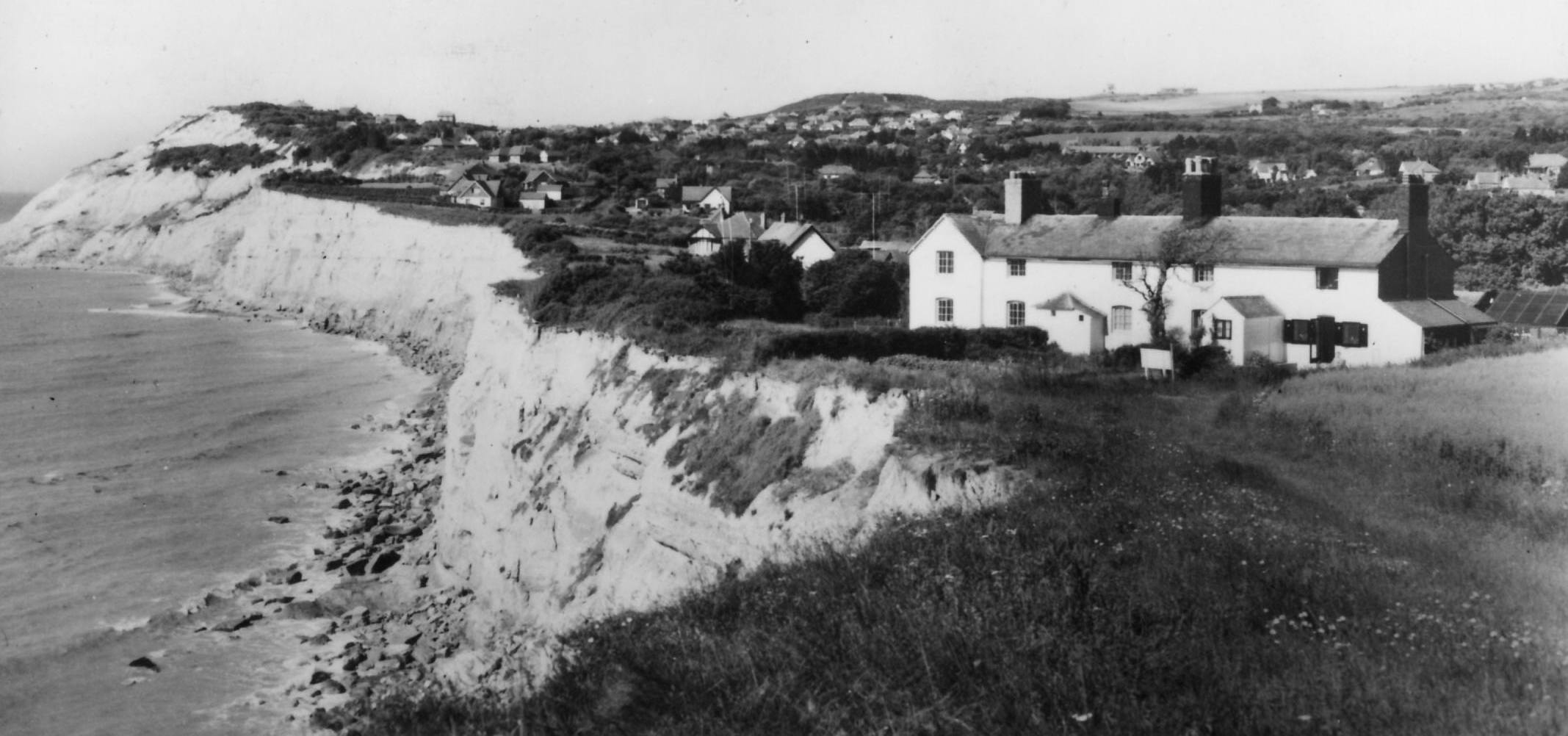 The former Haddocks Coastguard Station, probably in the late 1930s.
The former Haddocks Coastguard Station, probably in the late 1930s.
1882 - The Ransom’s Hastings Directory for 1882 said 'the sea below [the East Hill] is fast carrying masses of rock away'.
1882 April 8 - The Hastings Observer said that the East Hill was one of the many attractions of Hastings, and the gorse on it added to the enjoyable features. 'It is a pity, therefore, that there should be so much destruction of property as has taken place of late. Many of the poor inhabitants of the Old Town, we believe, are in the habit of cutting down large quantities [of gorse] at a time, and carrying it away for fuel. Then again it is almost a daily occurrence for some mischievous boy or youth to set fire to the gorse, so that nothing is left but a large number of burnt sticks, which make the scene as dull and dismal as it could well be.' There had been many complaints about this treatment of the gorse, and the Observer urged it should be stopped. That August, the Council appointed an extra police constable for the East and West Hills, with the Milward Estate paying half the costs.
1883 Feb 9 - The Hastings News reported that the Hastings Council meeting on 2 February had received plans for creating four roads on the Stonefield section of the Milward Estate: Milward Road, Milward Crescent, Nelson Road and Wellington Road (from Plynlimmon to Milward Road). The Council had discussed this several times before. There had been problems with the steep slopes at what was to be the junction of Stonefield Road, Wellington Road and Milward Road. The report was agreed, on condition that proper access was made from Wellington Road to the footpaths leading across the West Hill. At the meeting fears were expressed about these roads opening up all the West Hill to development. Cllr Eaton 'looked upon it as the thin end of the wedge to take the hills away from the public'. This was brought up again at the next Council meeting on 2 March, when Cllr Catt proposed sending a deputation of senior councillors and officers to meet the trustees and owners of the Milward Estate to try to keep open the East and West Hills and the glens. He said the Council should secure free access to them, as he feared development was likely to encroach on land of which the public had had the free use for very many years. The West Hill was especially under threat, as the Sayer-Milward family intended in a few weeks to sell portions of the land for which the Council had passed plans. Cllr Catt did not think the family would lose by giving over the West Hill to the people, because the knowledge that it was permanent open space would increase the value of the building plots adjoining it that they were to sell. The Council agreed Cllr Catt’s proposal, hoping the trustees would grant a lease on reasonable terms. But the Council meeting on 5 October 1883 heard that, following discussions, the trustees had submitted a report demanding nearly £20,000 for the lease of the two hills for just 21 years. This was considered excessive, and the offer was rejected. The News of 12 October said 'A cooler piece of selfishness has never been penned'.
1884 Nov 7 - Hastings Council officers reported that, after much negotiation, an agreement had been reached with the Milward Estate vendors for the purchase of the freehold of the West and East Hills for £20,000, with Ecclesbourne Glen being excluded. The Council accepted the deal, but the Hastings News of 14 November commented: 'The price demanded is a large one for the privilege of retaining that which has been practically the right of the inhabitants for centuries - the free use of these hills as a place of healthy recreation.' The News much regretted the exclusion of Ecclesbourne Glen, 'one of the most charming and bijou of sylvan nooks'. On 7 May 1886 the Council endorsed the final deal with the Milward Estate, with the conveyance taking place on 14 April 1888. The Council purchased 24 acres of the West Hill and 60 acres of the East Hill for £24,000 (about £3.2 million today), 'to be kept as open spaces for public use in perpetuity'. The cost included upgrading Rocklands Lane, but with the allotments surrounded by earthworks on top of the East Hill left out of the deal, as they were owned by All Saints Church. But the price continued to be widely considered as far too high because for many years the land had in practice been common land and therefore not available for development. The 1888 coveyance contained several covenants for the East Hill, including that the Council 'will maintain the whole area ... for ever hereafter as open spaces' and 'will not carry on, or cause or permit to be carried on, any trade, business or manufacture.' But in March 1963, when the Council bought 445 acres of land from Major Calisle-Sayer (the inheritor of the Milward Estate), all the covenants were scrapped.
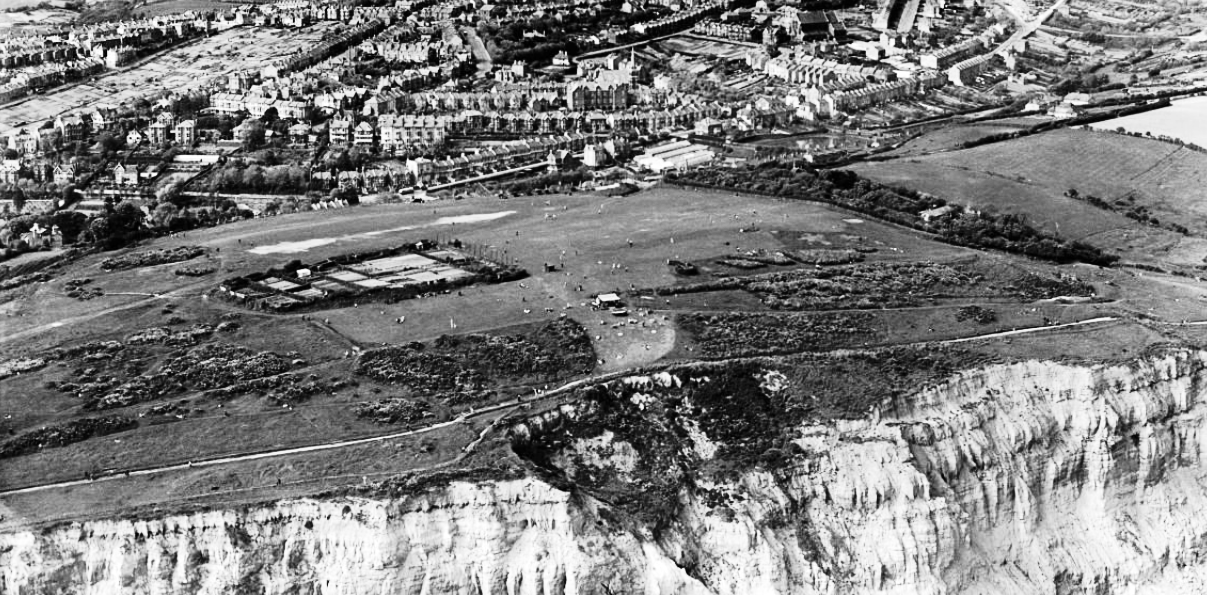 The East Hill in 1931. The white marks behind the allotments are a football pitch. Rocklands caravan park was then just a field. The long white path near the cliff edge is now gone, and today's path is the fainter one inland.
The East Hill in 1931. The white marks behind the allotments are a football pitch. Rocklands caravan park was then just a field. The long white path near the cliff edge is now gone, and today's path is the fainter one inland.
1887 May - Hastings Council took steps to stop Rye boats coming ashore between Ecclesbourne and Warren Glens to load blue stone from the beach, a valuable commodity which the council had the rights to.
1891 Autumn - The first idea for an East Hill lift was put forward, following the opening of the West Hill lift in March 1891. In its early days the West Hill lift looked like being a financial success, so a group of local businessmen proposed building another one, on the East Hill. Hastings Council had bought the East and West Hills from the Milward Estate in 1888, and local entrepreneurs hoped that this had opened the door for them to make some money by exploiting the tourist potential of the hills. They had been given the go-ahead for the West Hill lift, but the East Hill project was different. A lift could only be built there if certain stipulations of its conveyance were waived by the man in charge of the estate, the Rev William Sayer-Milward. The local business folk were initially optimistic that the Reverend would be helpful, not least because one of their group, Hastings solicitor and estate agent Alfred Sayer, was his brother. But the Reverend strongly objected to the idea, saying in a letter of May 1892 that 'all the residents in Hastings to whom I have spoken on the subject do not consider that such a lift is desirable'. The speculators then abandoned the scheme, publicly blaming the Reverend, but in truth also realising that the West Hill lift was not turning out to be the success that they had hoped. In December 1893 the company owning the lift went bust, with debts of £7,000. But the idea for an East Hill lift did not go away, and it was revived in the late 1890s, following the opening of the large golf course on the hill in 1895. In August 1898 Hastings councillors and aldermen, many of whom were golfers, decided to see if the Reverend would change his mind. They also thought it should be built and run by Hastings Council, rather than by a private company, because of the financial risks involved. After much discussion, the Reverend gave his support in 1900, and in February 1901 the council granted itself planning permission for the project.
1892 - In Coastguard Lane, Fairlight, two almshouses were erected and endowed by the Rev William Batley, who lived at 90 Old London Road, Hastings. Both are still there.
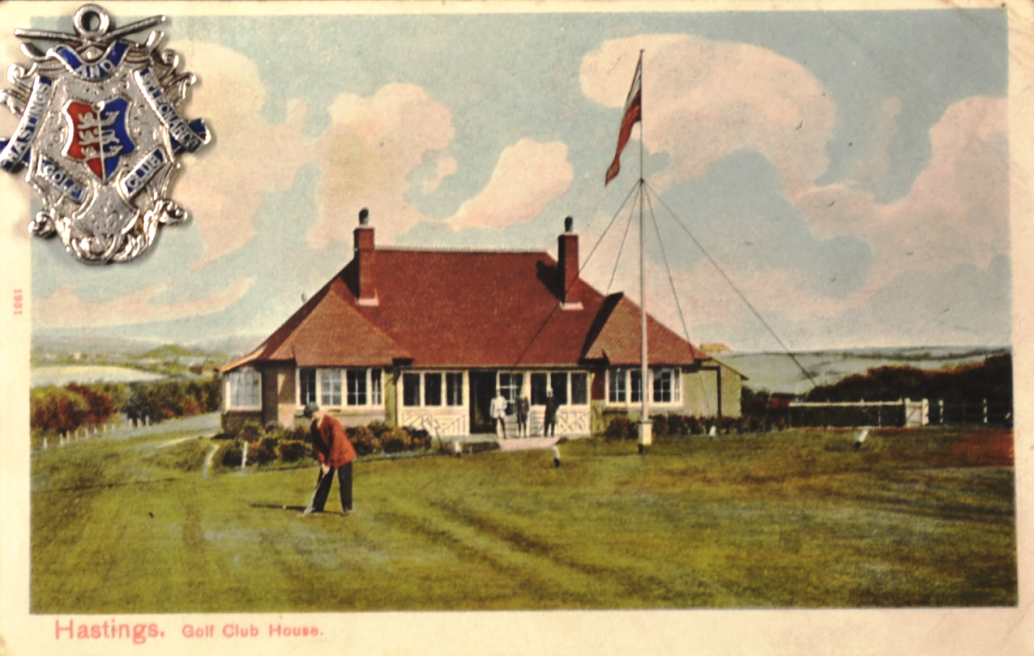 A postcard of the 1895-1924 golf club house, with a club badge attached.
A postcard of the 1895-1924 golf club house, with a club badge attached.
1893 March 8 - A golf club should be started in Hastings, a packed public meeting at the town hall agreed. The meeting had been called by the mayor in response to an offer by the Rev William Sayer-Milward to grant 12 acres of his ground adjoining the East Hill at a very nominal rent. The key campaigner was the 'clever caricaturist' Harry Furniss, who had done much preparatory work before the meeting. He was the first speaker, saying 'in an able and humorous speech', that golf was becoming increasingly popular in fashionable circles, and he was surprised links had not been established in Hastings long ago. He had many friends in London who would join the club and come to Hastings. 'Golfers would only come in the winter, and not in the summer, when the "cheap tripper", who was ruining Hastings, could have the hill to himself.' The club was formed at the end of the meeting, with £70 being promised by many subscribers. The Hastings Council meeting on 7 April gave a three year sanction for the laying out of golf links on the East Hill, under the supervision of the borough surveyor. But there was soon much protest at the way the hill was being cleared of gorse. Dr Elizabeth Blackwell, the first woman ever to graduate in medicine (in 1849), who lived at Exmouth Place, wrote to the Hastings Observer (29 April 1893) saying the top of the hill was 'a scene of desolation'. The west side of the hill had been 'reduced to a desert, covered with smouldering rounds of ruined soil - a desert which the first heavy rain will convert into a quagmire'. The following week, an anonymous correspondent complained about the way the damage had been done by a private club run by gentlemen out of touch with the wishes of most people. In addition 'the beauty of our East Hill is already considerably lessened by the jerry-built paving-stone steps, and old parade railings, with which the chief approach has been disfigured'. A club house was built at the junction of Barley Lane and Rocklands Lane, opening in 1895. During 1895 the Reverend supplied more land (flat) to make it an 18-hole course (it had been nine). The club house was partially destroyed by fire on 6 December 1898. In 1924 the Fishponds Farmhouse further up Barley Lane became the club house and the course spread as far east as Fairlight Glen, before going out of use in 1958.
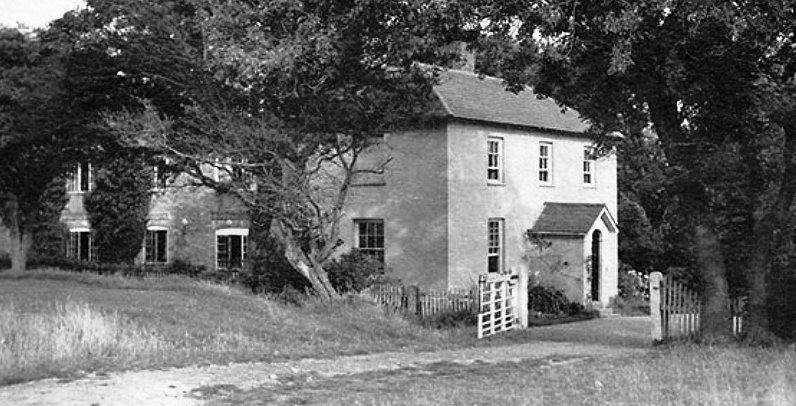 The old Fishponds Farmhouse off Barley Lane when it was the club house of the Hastings Downs Golf Club.
The old Fishponds Farmhouse off Barley Lane when it was the club house of the Hastings Downs Golf Club.
1893 Sept - Hastings Council bought from the Crown the foreshore in front of the town, from Ecclesbourne Glen stream to Grosvenor Gardens, including the 18 acres from Rock-a-Nore to Ecclesbourne that formed part of the Country Park when it was set up in 1971.
1896 June 26 - The Hastings News reported that a father of three fell to his death over the cliff near Fairlight Glen as he tried to escape arrest by a police officer on Sunday 21 June. John Towner, 28, a bricklayer of Halton, was one of a dozen men playing cards on the high cliff just to the west of Fairlight Glen that Sunday morning. When they were challenged by a constable and a gamekeeper, it was claimed that Towner attempted to jump onto a ledge, but missed, and fell more than 200 feet to his death in Covehurst. But his father believed he was pushed onto the rocks below. The News said about Ecclesbourne and Fairlight Glens that 'The beautifully wooded spots are among the greatest frequented by visitors to Hastings, being almost one of the first places of interest.' But the inquest, held at Fishponds Farmhouse, was told that a police officer was regularly posted to the glens area in order to 'prevent the nuisance of selling things and begging,' and 'the nuisance caused by people who recited the history of the Lover’s Seat'. The scene of the tragedy was to the south of the New Barn pond, on the part of the cliff the inquest was told was known as ‘Cliff Field’. This was said to be on one side of a dip in the ground, with ‘New Shine’ the part of the cliff on the other side. The party of men, with many dogs, was sighted playing cards in some bushes by the patrolling PC Baldwin at about 11.30. He thought the people carrying out 'this nefarious Sunday morning pursuit' may also have been poaching, so he went and called out the Rev William Sayer-Milward’s gamekeeper Tom Barnes, who lived in Little Warren Cottage. When the pair approached the card-players, they scattered in all directions. Towner ran and jumped through bushes, hoping to land on a ledge just below the cliff-top. A witness, Henry Brett, a labourer of High Bank, was in the Covehurst and saw Towner fall head first down the cliff. He was 'dashed on a ridge at the bottom'. PC Baldwin and some other men found the body 'in a terribly mangled condition'. Towner was a 'quiet, reserved man', who lived in Priory Road, opposite Ann Street. He left a widow and three very young children. His father, also John Towner, lived nearby at 28 Albion Street, Halton (where the Halton flats are today). John senior was a respected boatman, and the many boatmen on the seafront mounted half-mast flags in sympathy. He alleged in the inquest that Tom Barnes had pushed his son over the cliff, but none of the evidence from the several witnesses backed his claim. His calls for the inquest to be adjourned while he put together his evidence were refused.
1898 April - Hastings Council gave the Rev Sayer-Milward permission to lay out a road on the West Hill for a new housing development. The 360-yard long road, between the top of Croft Road and the junction of Alpine Road and Priory Road, was to be called Collier Road, after the 18th century Collier family. In August 1898 the Hastings Water Committee bought land from the Rev Sayer-Milward for £500 at Fairlight Down to construct the Fairlight Reservoir, between Mill Lane and Fairlight Road.
